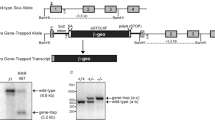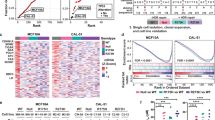Abstract
Mutations in the p53 tumour-suppressor gene are the most frequently observed genetic lesions in human cancers. To investigate the role of the p53 gene in mammalian development and tumori-genesis, a null mutation was introduced into the gene by homologous recombination in murine embryonic stem cells. Mice homozygous for the null allele appear normal but are prone to the spontaneous development of a variety of neoplasms by 6 months of age. These observations indicate that a normal p53 gene is dispensable for embryonic development, that its absence predisposes the animal to neoplastic disease, and that an oncogenic mutant form of p53 is not obligatory for the genesis of many types of tumours.
This is a preview of subscription content, access via your institution
Access options
Subscribe to this journal
Receive 51 print issues and online access
$199.00 per year
only $3.90 per issue
Buy this article
- Purchase on Springer Link
- Instant access to full article PDF
Prices may be subject to local taxes which are calculated during checkout
Similar content being viewed by others
References
Lane, D. P. & Crawford, L. V. Nature 278, 261–263 (1979).
Linzer, D. I. H. & Levine, A. J. Cell 17, 43–52 (1979).
Sarnow, P., Ho, Y. S., Williams, J. & Levine, A. J. Cell 28, 387–394 (1982).
Werness, B. A., Levine, A. J. & Howley, P. M. Science 248, 76–79 (1990).
Eliyahu, D. et al. Nature 312, 646–649 (1984).
Parada, L. F. et al. Nature 312, 649–651 (1984).
Jenkins, J. R., Rudge, K. & Currie, G. A. Nature 312, 651–654 (1984).
Jenkins, J. R., Rudge, K., Chumakov, P. & Currie, G. A. Nature 317, 816–818 (1985).
Finlay, C. A., Hinds, P. W. & Levine, A. J. Cell 57, 1083–1093 (1989).
Eliyahu, D. et al. Proc. natn. Acad. U.S.A. 86, 8763–8767 (1989).
Mercer, W. F. et al. Proc. natn. Acad. Sci. U.S.A. 87, 6166–6170 (1990).
Baker, S. J., Markowitz, S., Fearon, E. R., Willson, J. K. V. & Vogelstein, B. Science 249, 912–915 (1990).
Diller, L. et al. Molec. cell. Biol. 10, 5772–5781 (1990).
Michalovitz, D., Halevy, O. & Oren, M. Cell 62, 671–680 (1990).
Chen, P.-L., Chen, Y., Brookstein, R. & Lee, W.-H. Science 250, 1576–1580 (1990).
Mowat, M., Cheng, A., Kicumca, N., Bernstein, A. & Benchimol, S. Nature 61, 2777–2781 (1985).
Ben David, Y., Prideaux, V. R., Chow, V., Benchimol, S. & Bernstein, A. Oncogene 3, 179–185 (1988).
Hollstein, M., Sidransky, D., Vogelstein, B. & Harris, C. C. Science 253, 49–53 (1991).
Vogelstein, B. Nature 348, 681–682 (1990).
Malkin, D. et al. Science 250, 1233–1238 (1990).
Srivastava, S., Zou, Z., Pirollo, K., Blattner, W. & Chang, E. H. Nature 348, 757–749 (1990).
Stürzbecher, H.-W. et al. Oncogene 5, 795–801 (1990).
Bischoff, J. R., Friedman, P. N., Marshak, D. R., Prives, C. & Beach, D. Proc. natn. Acad. Sci. U.S.A. 87, 4766–4770 (1990).
Shaulsky, G., Ben-Ze'ev, A. & Rotter, V. Oncogene 5, 1707–1711 (1990).
Marshall, C. J. Cell 64, 313–326 (1990).
Levine, A. J., Momand, J. & Finlay, C. A. Nature 351, 453–456 (1991).
Gannon, J. V. & Lane, D. P. Nature 329, 456–458 (1987).
Braithwaite, A. W. et al. Nature 329, 458–460 (1987).
Fields, S. & Jang, S. K. Science 249, 1046–1049 (1990).
Raycroft, L., Wu, H. & Lozano, G. Science 249, 1049–1051 (1990).
Rogel, A., Popliker, M., Webb, C. & Oren, M. Molec. cell. Biol. 5, 2851–2855 (1985).
Mansour, S. L., Thomas, K. R. & Capecchi, M. R. Nature 336, 348–352 (1988).
Soriano, P., Montgomery, C., Geske, R. & Bradley, A. Cell 64, 693–702 (1991).
Soussi, T., de Fromentel, C. C. & May, P. Oncogene 5, 945–952 (1990).
McMahon, A. & Bradley, A. Cell 62, 1073–1085 (1990).
Bradley, A. in Tetratocarcinomas and Embryonic Stem Cells: A Practical Approach (ed. Robertson, E. J.) 113–151 (IRL, Oxford, 1987).
Wolf, D. & Rotter, V. Molec. cell. Biol. 4, 1402–1410 (1984).
Maita, K. et al. Toxicol. Pathol. 16, 340–349 (1988).
Squire, R. A. et al. in Pathology of Laboratory Animals Vol. II (eds Benirschke, K. et al.) 1054–1055 (Springer, New York, 1978).
Lavigueur, A. et al. Molec. cell. Biol. 9, 3982–3991 (1989).
Stutman, O. Fed. Proc. Fed. Am. Soc. exp. Biol. 33, 2028–2032 (1974).
Stevens, L. C. J. natn. Cancer Inst. 50, 235–242 (1974).
Yandell, D. W. Proc. Am. Assoc. Cancer Res. 32, 459–460 (1991).
Bienz, B., Zakut-Houri, R., Libresco, S., Givol, D. & Oren, M. EMBO J. 3, 2179–2183 (1984).
Jarvis, D. L., Lanford, R. E. & Butel, J. S. Virology 134, 168–176 (1984).
Sepulveda, A. R. et al. Cancer Res. 49, 6108–6117 (1989).
Slagle, B. L., Lanford, R. E., Medina, D. & Butel, J. S. Cancer Res. 42, 2155–2162 (1984).
Harlow, E., Franza, B. R. Jr & Schley, C. J. Virol. 55, 533–546 (1985).
Harlow, E., Crawford, L. V., Pirn, D. C. & Williamson, N. M. J. Virol. 39, 861–869 (1981).
Yewdell, J. W., Gannon, J. V. & Lane, D. P. J. Virol. 59, 444–452 (1986).
Dippold, W. G., Jay, G., DeLeo, A. B., Khoury, G. & Old, L. J. Proc. natn. Acad. Sci. U.S.A. 78, 1695–1699 (1981).
Coffman, R. L. & Weissman, I. K. J. exp. Med. 153, 269–279 (1981).
Alison, R. H., Lewis, D. J. & Montgomery, C. A. Vet. Path. 24, 226–230 (1987).
Author information
Authors and Affiliations
Rights and permissions
About this article
Cite this article
Donehower, L., Harvey, M., Slagle, B. et al. Mice deficient for p53 are developmentally normal but susceptible to spontaneous tumours. Nature 356, 215–221 (1992). https://doi.org/10.1038/356215a0
Received:
Accepted:
Issue Date:
DOI: https://doi.org/10.1038/356215a0
This article is cited by
-
Combined absence of TRP53 target genes ZMAT3, PUMA and p21 cause a high incidence of cancer in mice
Cell Death & Differentiation (2024)
-
Pharmacological reactivation of p53 in the era of precision anticancer medicine
Nature Reviews Clinical Oncology (2024)
-
Decoding p53 tumor suppression: a crosstalk between genomic stability and epigenetic control?
Cell Death & Differentiation (2024)
-
Genomic and functional impact of Trp53 inactivation in JAK2V617F myeloproliferative neoplasms
Blood Cancer Journal (2024)
-
Genome-wide CRISPR screening identifies a role for ARRDC3 in TRP53-mediated responses
Cell Death & Differentiation (2024)
Comments
By submitting a comment you agree to abide by our Terms and Community Guidelines. If you find something abusive or that does not comply with our terms or guidelines please flag it as inappropriate.



